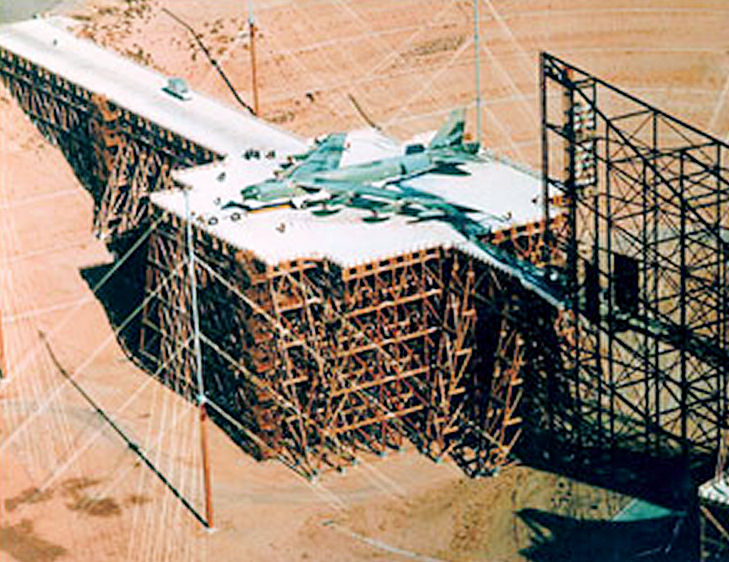AlmightyTallest
Posts: 279
Joined: 2/25/2014
Status: offline

|
I can't give out any concrete details but EMP protection factors big on the military equipment we manufacture. I can point you guys to this to perhaps help give an idea that a lot of thought and effort has gone into protection of U.S. military equipment during a nuclear exchange. I am unfamiliar with other countries solutions and testing to ensure mil-spec equipment meets such a specification.
https://en.wikipedia.org/wiki/ATLAS-I


quote:
ATLAS-I (Air Force Weapons Lab Transmission-Line Aircraft Simulator), better known as TRESTLE, or simply the Trestle, was the codename for a unique electromagnetic pulse (EMP) generation and testing apparatus built between 1972 and 1980 during the Cold War at Sandia National Laboratories near Kirtland Air Force Base in Albuquerque, New Mexico.[1]
ATLAS-I was the largest NNEMP (Non-Nuclear Electromagnetic Pulse) generator in the world, designed to test the radiation hardening of strategic aircraft systems against EMP pulses from nuclear warfare. Built at a cost of $60 million, it was composed of two parts: a powerful Marx generator capable of simulating the effects of a high-altitude nuclear explosion (HANE) of the type expected during a global nuclear war, and a giant wooden trestle built in a bowl-shaped arroyo, designed to elevate the test aircraft above ground interference and orient it below the pulse in a similar manner to what would be seen in mid-air.[2]
TRESTLE is the world's largest structure composed entirely of wood and glue laminate.[3
quote:
The Marx generator providing the EMP pulse generated 200 gigawatts of electromagnetic flux at an electrical potential of 10 megavolts,[4] powerful enough to reliably reproduce (at short range) the deleterious effects of a thermonuclear detonation on electronic circuitry as created by such examples as the HARDTACK I, ARGUS and DOMINIC I (Operation Fishbowl) high altitude nuclear tests. The generator itself was mounted at the end of a long, diagonal wooden scaffold structure, located above and to one side of the aircraft platform, with the primary receiving tower located at equal elevation on the other side of the arroyo.
Due to their higher flight altitude and nuclear payload, Strategic Air Command bombers were the primary object of the tests, but fighters, transport aircraft and even missiles were also tested for EMP hardness on TRESTLE. In addition to electronics survivability tests, numerous sensors located beneath and to the sides of the aircraft would gather additional data on the airframe's EMP permeability to be used in design considerations for future Cold War aircraft.
The advances made in EMP generation technology by Sandia during the operation of TRESTLE greatly assisted in the construction of the much more powerful 40 megavolt, 50 terawatt (50,000 gigawatt) Z Machine at Sandia during the 1990s. Technological advances during the 2000s (decade) have since boosted this output to 290 terawatts (290,000 gigawatts), high enough to actually study nuclear fusion at the point of detonation.[5]
So in the year 2000 they upgraded the system to a power level that can allow study of nuclear fusion at the point of detonation.... And they tested cruise missiles and other aircraft.
I did come across this Russian test of EMP effects data, haven't read through it yet but looks promising to help give some idea of various EMP effects on aircraft and such.
http://ed-thelen.org/EMP-ElectroMagneticPulse.html

quote:
Above: USSR Test �184� on 22 October 1962, �Operation K� (ABM System A proof tests) 300-kt burst at 290-km altitude near Dzhezkazgan. Prompt gamma ray-produced EMP induced a current of 2,500 amps measured by spark gaps in a 570-km stretch of 500 ohm impedance overhead telephone line to Zharyq, blowing all the protective fuses. The late-time MHD-EMP was of low enough frequency to enable it to penetrate the 90 cm into the ground, overloading a shallow buried lead and steel tape-protected 1,000-km long power cable between Aqmola and Almaty, firing circuit breakers and setting the Karaganda power plant on fire.
quote:
In the Pacific nuclear high altitude megaton tests, communications using ionosphere-reflected high frequency (HF) radio were disrupted for hours at both ends of the geomagnetic field lines which passed through the detonation point. However, today HF is obsolete and the much higher frequencies involved do not suffer so much attenuation. Instead of relying on the ionosphere and conducting ocean to form a reflecting wave-guide for HF radio, the standard practice today is to use microwave frequencies that penetrate right through the normal ionosphere and are beamed back to another area by an orbital satellite. These frequencies can still be attenuated by severe ionisation from a space burst, but the duration of disruption will be dramatically reduced to seconds or minutes.

quote:
Above: locations of test aircraft which suffered EMP damage during Operation Fishbowl in 1962. In testimony to 1997 U.S. Congressional Hearings on EMP, Dr. George W. Ullrich, the Deputy Director of the U.S. Department of Defense's Defense Special Weapons Agency (now the DTRA, Defence Threat Reduction Agency) said that the lower-yield Fishbowl tests after Starfish 'produced electronic upsets on an instrumentation aircraft that was approximately 300 kilometers away from the detonations.' The report by Charles N. Vittitoe, 'Did high-altitude EMP (electromagnetic pulse) cause the Hawaiian streetlight incident?', Sandia National Labs., Albuquerque, NM, report SAND-88-0043C; conference CONF-880852-1 (1988) states on page 3: 'Several damage effects have been attributed to the high-altitude EMP. Tesche notes the input-circuit troubles in radio receivers during the Starfish [1.4 Mt, 400 km altitude] and Checkmate [7 kt, 147 km altitude] bursts; the triggering of surge arresters on an airplane with a trailing-wire antenna during Starfish, Checkmate, and Bluegill [410 kt, 48 km altitude] ...'
Note that these are early 60's tests which prompted programs like ATLAS later on to correct for susceptibility of systems to EMP.
< Message edited by AlmightyTallest -- 1/30/2016 3:24:42 PM >
|
 Printable Version
Printable Version










 . There are different probabilities based on tech age. We're not showing everything on the message log
. There are different probabilities based on tech age. We're not showing everything on the message log 

 )
) 
 New Messages
New Messages No New Messages
No New Messages Hot Topic w/ New Messages
Hot Topic w/ New Messages Hot Topic w/o New Messages
Hot Topic w/o New Messages Locked w/ New Messages
Locked w/ New Messages Locked w/o New Messages
Locked w/o New Messages Post New Thread
Post New Thread